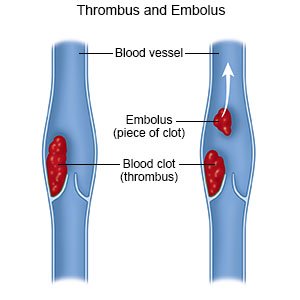Mechanical Thrombectomy
Medically reviewed by Drugs.com. Last updated on Aug 4, 2025.
What do I need to know about mechanical thrombectomy?
Mechanical thrombectomy is an emergency procedure used to remove a blood clot from a blood vessel (vein or artery). The procedure is usually done on arteries. Examples include hip and clavicle (collarbone) arteries. A clot can also be removed from a vein or artery in the brain to help prevent a stroke. Thrombectomy is usually done if other procedures did not work and the clot is at risk for causing medical problems. A clot that breaks free and travels to the lungs can cause a pulmonary embolism. A clot that travels to the brain can cause a stroke. Even if the clot does not break free, it can prevent blood flow to body areas.
 |
How do I prepare for a mechanical thrombectomy?
- Your surgeon will talk to you about how to prepare for your procedure. You may be told to not to eat or drink anything after midnight on the day of your procedure. Your surgeon will tell you what medicines to take or not take on the day of your procedure.
- Contrast liquid may be used to help the clot show up better in x-ray pictures. Tell the healthcare provider if you have ever had an allergic reaction to contrast liquid.
- Arrange to have someone drive you home after your procedure. You may need to stay in the hospital for several days.
Related medications
What will happen during the procedure?
The type of anesthesia you get will depend on where the procedure will happen. For a leg or collarbone procedure, you may be given local or spinal anesthesia to numb the area. You will not feel pain, but you may feel pressure. For a brain procedure, you may be given conscious sedation. General anesthesia may be used for any type of thrombectomy to keep you asleep and free from pain. Your surgeon will use an x-ray to find the blood clot.
- For a leg blood vessel, your surgeon will make an incision in your leg. The incision will be higher up your leg than the blood clot. Your surgeon will make an incision into an artery and insert a catheter (thin tube). An artery in the groin or behind the knee is usually used. Your surgeon will guide the catheter to the clot. The catheter has a balloon on the tip. Your surgeon will inflate the balloon at the tip and then pull the catheter back. This will dislodge the clot so it can be removed.
- For a collarbone blood vessel, your surgeon will make an incision along your collarbone. Your surgeon will open the artery and remove the clot. You may be given blood thinning medicine before and after the thrombectomy.
- For a brain blood vessel, your surgeon will place a catheter through your skin and into a blood vessel. The catheter will be guided up to the blockage. A device called a stent retriever may be used to remove the clot. The device is a wire mesh that closes around the clot so it can be pulled out of the blood vessel. Your surgeon may also inject medicines to dissolve a clot or treat a spasm in a blood vessel.
 |
What should I expect after the procedure?
You may have swelling or pain in the procedure area. Your healthcare provider may give you medicines to reduce pain or swelling. You may be able to go home soon after your procedure. You may need to stay in the hospital for up to 1 week after an intracranial thrombectomy. Your provider may have you lie still for several hours right after your procedure. Your provider may then have you walk around to help prevent another blood clot.
What are the risks of mechanical thrombectomy?
The artery may be punctured or torn. You may have a heart attack if pieces of the blood clot break off during the procedure and travel to your heart or lungs. Other arteries may become blocked. You may have heavy bleeding and swelling when blood flow is restored. A thrombectomy in a brain artery can cause heavy bleeding into your brain.
Care Agreement
You have the right to help plan your care. Learn about your health condition and how it may be treated. Discuss treatment options with your healthcare providers to decide what care you want to receive. You always have the right to refuse treatment. The above information is an educational aid only. It is not intended as medical advice for individual conditions or treatments. Talk to your doctor, nurse or pharmacist before following any medical regimen to see if it is safe and effective for you.© Copyright Merative 2025 Information is for End User's use only and may not be sold, redistributed or otherwise used for commercial purposes.
Further information
Always consult your healthcare provider to ensure the information displayed on this page applies to your personal circumstances.
